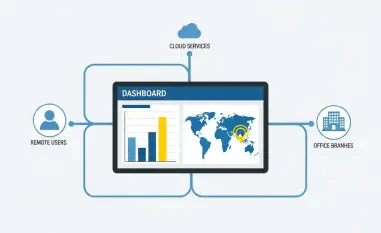In an era where cyber threats evolve at an alarming speed, staying ahead of malicious actors has become a critical imperative for organizations worldwide, as the cybersecurity landscape in 2025 is defined by increasingly sophisticated dangers like ransomware, phishing schemes, and advanced persistent threats (APTs) that drain trillions of dollars from businesses annually. As industries accelerate their digital transformation, the demand for robust threat intelligence solutions has surged to unprecedented levels. This article shines a spotlight on the leading companies that are setting the standard with end-to-end protection platforms, designed to safeguard organizations from an ever-widening array of risks. These trailblazers are not merely responding to attacks but are actively predicting and preventing them through cutting-edge technology and strategic innovation.
The focus here is on firms that deliver comprehensive systems spanning endpoints, networks, cloud environments, and beyond, ensuring no vulnerability is left unchecked. Each company has been meticulously assessed for its distinct capabilities, features, and alignment with diverse organizational needs, from sprawling enterprises to nimble mid-size firms. Cybercrime operates without borders, and these leaders match that global scope with vast data networks and real-time insights, empowering businesses to stay a step ahead of adversaries. Their adaptability to multi-cloud and hybrid IT setups is vital as digital infrastructures become more distributed, expanding potential attack surfaces. What unites them is a commitment to innovation, often harnessing artificial intelligence (AI) and machine learning to anticipate threats, automate defenses, and reduce reliance on reactive measures, marking a pivotal shift in cybersecurity strategy.
Beyond technical prowess, accessibility remains a core principle for many of these providers. While some cater to large-scale operations with deep, data-intensive tools, others prioritize affordability, ensuring smaller businesses can access top-tier protection without financial strain. Specialization also plays a significant role, with certain companies excelling in niche areas like dark web surveillance or endpoint security, allowing for tailored solutions based on specific risks. Integration with existing systems, rapid incident response, and a focus on cloud compatibility further define their offerings, reflecting the dynamic and competitive nature of the current cybersecurity environment. As the industry matures, these leaders emphasize proactive defense and global collaboration, painting a picture of a field that values prevention and interconnected strategies to combat borderless threats.
Industry Trends Shaping Threat Intelligence
The Rise of Proactive and Predictive Security
The transition to proactive security stands as a transformative trend in the cybersecurity realm this year. Rather than merely reacting to breaches after they occur, leading companies are investing heavily in predictive technologies that identify and neutralize risks before they can manifest into full-scale attacks. This shift is driven by advanced analytics, AI algorithms, and machine learning models that process massive datasets to forecast potential vulnerabilities. By focusing on prevention, these firms are setting a new benchmark, reducing the financial and reputational damage that often follows a successful cyberattack. The emphasis on foresight over hindsight is reshaping how organizations approach their defense mechanisms, prioritizing early intervention as a core strategy.
This proactive stance also reflects a broader industry recognition that cyber threats are becoming more complex and multi-layered. Tools that offer predictive risk scoring and real-time threat monitoring are now essential, enabling security teams to allocate resources more effectively and address weaknesses before they are exploited. The cost-effectiveness of this approach cannot be overstated—preventing an attack is almost always less expensive than recovering from one. As adversaries adopt similarly sophisticated tactics, the ability to anticipate their moves through intelligence-driven platforms provides a critical edge, ensuring that businesses are not caught off guard by emerging dangers.
Cloud and Hybrid Environment Focus
With the widespread adoption of cloud and hybrid IT systems across enterprises, securing these environments has emerged as a top priority for threat intelligence providers. The shift to distributed infrastructures has significantly expanded attack surfaces, introducing new vulnerabilities that traditional security measures often fail to address. Leading firms are responding with cloud-native solutions and hybrid-compatible platforms that ensure seamless protection across diverse setups. This adaptability is crucial for organizations managing multi-cloud operations, where data and applications are spread across various providers and on-premises systems, requiring a unified defense strategy.
The focus on cloud security also underscores the need for scalability and flexibility in threat intelligence tools. As businesses continue to migrate critical operations to the cloud, providers are developing solutions that integrate effortlessly with these environments, offering real-time monitoring and automated threat responses. This trend is particularly vital for industries like finance and healthcare, where data sensitivity and regulatory compliance demand robust safeguards regardless of where information is stored. By prioritizing cloud and hybrid compatibility, these leaders are helping organizations navigate the complexities of modern IT landscapes while maintaining airtight security postures against evolving cyber risks.
Spotlight on the Top 10 Leaders
AI and Machine Learning Innovators
A defining characteristic of several top threat intelligence providers is their groundbreaking use of AI and machine learning to convert vast streams of data into actionable insights. These technologies enable platforms to detect anomalies, identify patterns, and predict potential threats in real time, significantly enhancing the speed and accuracy of responses. By automating much of the analysis process, such tools alleviate the burden on security operations centers (SOCs), allowing teams to focus on strategic decision-making rather than manual threat hunting. This capability is indispensable in an environment where attackers deploy increasingly sophisticated methods, often leveraging AI themselves to orchestrate large-scale campaigns.
Moreover, the integration of machine learning allows for continuous improvement of threat detection models as new data is ingested. This adaptability ensures that defenses evolve alongside emerging risks, maintaining relevance in a rapidly changing landscape. Companies excelling in this area often provide intuitive dashboards and automated remediation features, making complex data accessible even to organizations with limited cybersecurity expertise. The result is a marked reduction in response times and a stronger overall security posture, positioning these innovators as essential partners for businesses aiming to stay ahead of adversaries in a data-driven era.
Niche Experts and Specialized Solutions
While comprehensive, end-to-end protection remains a hallmark of all leading providers, several stand out for their specialized expertise in specific areas of threat intelligence. Some focus on external threat monitoring, delving into dark web activities and supply chain vulnerabilities to uncover risks that originate outside an organization’s immediate network. Others prioritize endpoint security, offering advanced protection for devices that are often the first point of entry for attackers. This specialization enables businesses to address their most pressing concerns with targeted precision, ensuring resources are allocated where they are needed most.
Such niche strengths are particularly valuable for organizations facing unique risk profiles. For instance, industries reliant on extensive vendor networks may benefit from providers that excel in third-party risk management, while those with a mobile workforce might prioritize endpoint-focused solutions. By carving out these distinct areas of expertise, these companies complement broader security frameworks, allowing for a layered defense approach. This trend toward specialization highlights the diversity of cyber threats and the need for tailored strategies, ensuring that even the most specific vulnerabilities are not overlooked in the pursuit of holistic protection.
Accessible Options for All Business Sizes
Accessibility and affordability are increasingly central to the offerings of many threat intelligence leaders, particularly for mid-size and smaller businesses that may lack the budgets of large corporations. These providers deliver enterprise-grade capabilities at a lower cost, ensuring that high-quality protection is not exclusive to well-funded entities. Features like user-friendly interfaces and scalable pricing models make it easier for organizations with limited resources to implement robust security measures without compromising on effectiveness. This democratization of threat intelligence is a significant step toward leveling the playing field in cybersecurity.
Additionally, these accessible solutions often come with comprehensive support services, such as guided implementation and 24/7 assistance, which are critical for firms without dedicated in-house security teams. By focusing on ease of use and cost efficiency, these leaders are addressing a previously underserved market segment, empowering smaller enterprises to defend against sophisticated threats that were once considered beyond their reach. This trend not only broadens the adoption of threat intelligence but also strengthens overall industry resilience, as smaller players become less viable targets for attackers seeking easy entry points into larger networks.
Key Differentiators and Organizational Fit
Scalability for Large Enterprises
For large enterprises and government entities, scalability and global reach are essential attributes of a threat intelligence provider. These organizations often operate across multiple regions with complex, interconnected IT environments that require robust, data-intensive solutions capable of handling vast amounts of information. Leading companies in this space offer platforms that deliver deep insights through predictive analytics and extensive global data networks, ensuring comprehensive visibility into potential threats. While these tools provide unparalleled protection for massive operations, they often come with higher costs and may require advanced SOC teams to fully leverage their capabilities.
The emphasis on scalability also extends to the ability to manage diverse infrastructures, from legacy systems to modern cloud deployments, without sacrificing performance. Providers catering to this segment prioritize customization, allowing their platforms to adapt to the unique needs of sprawling organizations. This flexibility is vital for sectors like finance or defense, where regulatory demands and high-stakes risks necessitate tailored approaches. Although the complexity of these solutions can pose a barrier for smaller entities, for large-scale operations, they represent a critical investment in safeguarding against the most sophisticated and persistent cyber threats.
Agility for Mid-Size and Smaller Firms
Mid-size and smaller firms benefit immensely from threat intelligence providers that emphasize agility and ease of deployment. These companies often balance powerful security features with simplicity, ensuring that organizations with limited budgets or technical expertise can still access top-tier protection. Solutions in this category are designed to be intuitive, often featuring plug-and-play setups and clear, actionable reporting that doesn’t overwhelm users. This focus on usability makes it possible for businesses to strengthen their defenses without the need for extensive training or dedicated cybersecurity staff.
Furthermore, affordability is a key differentiator for providers targeting this market. Many offer tiered pricing structures or modular services, allowing firms to scale their security investments as they grow. This approach ensures that even startups or regional businesses can implement effective threat intelligence strategies, protecting against risks that could otherwise be devastating. By prioritizing agility, these leaders enable smaller organizations to respond swiftly to threats, maintaining operational continuity and resilience in a landscape where every entity, regardless of size, is a potential target for cybercriminals.
Integration and Ecosystem Compatibility
Seamless integration with existing security tools and workflows is a crucial factor for many of the top threat intelligence providers. Organizations often rely on established systems such as Security Information and Event Management (SIEM), Security Orchestration, Automation, and Response (SOAR), or Endpoint Detection and Response (EDR), and compatibility with these platforms can significantly enhance overall effectiveness. Leaders in this area design solutions that fit into broader ecosystems, minimizing disruption and ensuring that new tools complement rather than conflict with current setups, thus maximizing long-term value.
This focus on integration also facilitates a more cohesive security strategy, where data and alerts from multiple sources are unified into a single, actionable framework. Such interoperability is especially important for businesses with layered defenses, as it reduces silos and improves response times during critical incidents. Providers excelling in this domain often offer APIs and customizable connectors to bridge gaps between disparate systems, ensuring a smooth transition for organizations upgrading their threat intelligence capabilities. This compatibility underscores the importance of a holistic approach, where every component of a security architecture works in harmony to counter evolving risks.













